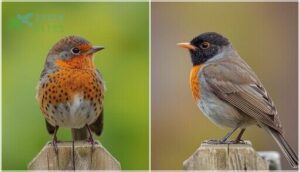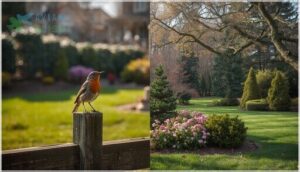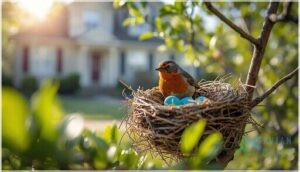This site is supported by our readers. We may earn a commission, at no cost to you, if you purchase through links.
That flash of orange-red against your lawn isn’t just any bird—it’s one of North America’s most recognizable songbirds, the American robin. You’ve probably seen dozens without realizing how extraordinary they are: these thrushes flip-flop their entire diet twice a year, form winter flocks with strict pecking orders, and somehow thrive everywhere from Alaskan tundra to Mexican highlands.
Their breast plumage inspired countless springtime poems, yet robins don’t actually signal spring—many stick around all winter, surviving on fermented berries in hidden roosts.
Understanding what makes these birds tick means recognizing the species that’s mastered the art of living alongside humans while maintaining wild instincts that stretch back millennia.
Table Of Contents
- Key Takeaways
- Identifying The American Robin
- American Robin Habitat and Range
- What American Robins Eat
- American Robin Behavior
- Migration Patterns of American Robins
- Breeding and Nesting Habits
- Conservation Status and Threats
- Attracting American Robins to Your Yard
- Frequently Asked Questions (FAQs)
- What are some fun facts about American Robins?
- Where can you find American Robins?
- What does the American Robin look like?
- What do American Robins eat?
- What are 3 facts about the American robin?
- What is the difference between an English robin and an American robin?
- Where do American robins live?
- Why are American robins so important?
- What does it mean when you keep seeing an American robin?
- What is special about the American robin?
- Conclusion
Key Takeaways
- American robins flip their diet dramatically between seasons—eating over 60% insects and earthworms during spring breeding, then switching to 90% fruit by fall and winter to survive when bugs disappear.
- These birds don’t actually signal spring’s arrival since many populations stay year-round in northern regions, surviving on fermented berries in winter roosts that can hold anywhere from dozens to over 700,000 individuals.
- Robins thrive across nearly every North American habitat from Alaskan tundra to Mexican highlands because they’ve mastered edge habitats where open ground meets protective cover, allowing them to exploit both natural and human-altered landscapes.
- Despite their abundance of 310-370 million birds, robins face serious threats from pesticide-contaminated earthworms, window collisions, feral cat predation, and habitat loss that you can directly counter by creating chemical-free yards with native berry plantings and fresh water sources.
Identifying The American Robin
You can spot an American robin from across the yard once you know what to look for. These thrushes have distinct features that set them apart from other backyard birds, and those features shift depending on age and sex.
Let’s break down the key physical traits that’ll help you identify robins with confidence.
Physical Characteristics
You’ll recognize the American Robin (Turdus migratorius) by its striking breast—that bright reddish-orange plumage colors stop you in your tracks. Notice the gray back, dark head, and yellow beak with its darker tip. White eye arcs and undertail coverts complete the American robin characteristics you’re observing.
The species measures 20-28 cm long with a 31-40 cm wingspan, weighing around 77 grams. The American Robin’s musical whistling songs are a distinctive feature of its behavior and communication.
Male Vs. Female Differences
You’ll spot subtle but meaningful differences between males and females. Males show brighter rusty-red breast plumage compared to females’ lighter reddish-orange tones—an example of sexual dimorphism in Turdus migratorius identification.
Key differences in monogamous pairs:
- Males display darker black heads; females appear blackish-gray
- Males average 77g; females 75.5g—minimal size differences
- Males sing complex “cheerily, cheer up” songs; females vocalize less
- Females construct nests; males defend territory aggressively during mating rituals
Understanding the species’ geographic range habits is essential for effective conservation.
Juvenile Vs. Adult Features
When you’re learning bird identification, juveniles break free from the adult template. From May through September, young robins wear dense black spots across their orange breasts—nature’s polka dots—while adults show smooth, uniform coloration. You’ll notice juveniles have paler, more mottled faces and whitish wing markings that adults lack during their molting process.
| Feature | Juvenile Turdus migratorius | Adult |
|---|---|---|
| Breast plumage development | Heavy black spotting, polka-dot pattern | Uniform orange-red, minimal mottling |
| Wing coverts | White-tipped feathers, pale streaks | Unmarked gray, no white spots |
| Head pattern | Pale eyebrow, mottled face | Dark head, defined white eye crescents |
| Tail shape | Narrow, tapered, grayish-brown | Broader, sturdy, darker feathers |
| Overall appearance | Brownish, scruffy, worn feathers | Clean gray back, brighter breast |
Understanding feather patterns and beak shape helps distinguish age classes. Juveniles retain stubby tails and scruffier wings until their first complete molt, while leg coloration remains similar across ages—a reassuring constant in an otherwise transforming bird.
American Robin Habitat and Range
American robins don’t stick to just one type of landscape—they’ve mastered the art of thriving almost anywhere. From dense northern forests to your own backyard, these adaptable birds shift their locations with the seasons and available resources.
Let’s break down where you’ll find them across the continent and what draws them to different environments throughout the year.
Geographic Distribution
The American Robin’s geographic range blankets North America from northern Alaska to central Mexico, spanning roughly 16 million square kilometers. Breeding populations are found across Canada’s 6.7 million square kilometers and throughout the continental U.S., where migration patterns shift populations southward each winter.
Range expansion continues as habitat fragments create new corridors, while geographic isolation has produced seven distinct subspecies showing varied population dynamics.
Preferred Environments
You’ll find these thrushes thriving where open woodlands meet edge habitats—forest borders, garden edges, and suburban lawns across North America. Within their Montana range, 32.4% of 380,494 km² represents prime ecological systems mixing trees with short grass.
Urban landscapes suit them well; cities, parks, and backyards offer ideal foraging grounds. Habitat fragmentation actually creates corridors they exploit, blending wildlife habitat with human spaces seamlessly.
Seasonal Habitat Shifts
When winter arrives, you’ll notice American Robins abandoning their breeding territories for large flocks concentrated in berry-rich woodlands—a striking Habitat Adaptation driven by Food Availability rather than temperature alone.
Seasonal Migration patterns vary widely; some birds travel from Alaska to Montana, while others shift just a few miles. Climate Change has extended their northern range, with Urban Ecology hotspots now hosting winter concentrations in parks where ornamental fruit persists.
What American Robins Eat
American robins aren’t picky eaters—they switch up their menu based on what’s available and what season it is. You’ll see them hopping across your lawn hunting for worms one day and raiding berry bushes the next.
Let’s break down what fuels these adaptable birds throughout the year.
Insects and Invertebrates
You’ll notice robins hunting with that signature head-tilt—they’re actually listening for earthworms moving underground, though vision guides most of their foraging. Their invertebrate diet makes up about 40% of what they eat, offering a protein punch that powers their energy and breeding success.
- Beetle bonanza: Beetles alone account for 40% of their insect prey, with ground beetles and weevils topping the menu
- Diverse palate: Robins consume invertebrates from over 107 families across 14 insect orders—talk about ecological flexibility
- Seasonal shift: During breeding season, invertebrate consumption jumps while nestlings feast on soft-bodied prey like caterpillars and earthworms
Fruits and Berries
When fruit-bearing shrubs ripen, robins become surprisingly picky consumers. You’ll find them targeting high-sugar species like dogwoods, wild grapes, and crabapples—fruit can dominate over 80% of their diet from August through January.
Their rapid gut passage time of roughly 48 minutes makes them efficient seed dispersers, spreading both native and invasive plants across landscapes as they forage and fly.
Robins digest fruit in just 48 minutes, turning them into prolific seed spreaders across the landscape
Seasonal Diet Changes
You’ll witness one of nature’s most dramatic dietary pivots as robins shift between protein-packed earthworms and sweet berries across the year. Their foraging strategies reflect pure survival math:
- Spring surge: Earthworms and insects dominate over 60% of intake during nesting season
- Summer shift: Ripening fruits gradually replace invertebrate prey
- Fall feast: Fruit jumps to 90%+ by volume as robins fatten for migration
- Winter specialization: Persistent berries sustain northern residents when bugs vanish
- Rapid switching: The entire diet flip happens in just 1–2 months
These seasonal shifts in nutrient acquisition let American robins exploit whatever food sources peak at the moment.
American Robin Behavior
American robins aren’t just pretty birds on your lawn—they’re active, social creatures with fascinating daily routines. If you watch them closely, you’ll notice patterns in how they hunt, interact with other robins, and defend their space.
Here’s what you need to know about their most distinctive behaviors.
Foraging and Feeding Habits
You’ve probably seen a robin hopping across your lawn, then suddenly striking the ground with precision. American robins rely on sharp vision to detect earthworms moving beneath the soil surface. They alternate short runs with motionless pauses, scanning for subtle prey movements. During breeding season, adults may deliver over 350 food items daily to nestlings, switching from invertebrate-rich lawns in spring to fruit-bearing shrubs by fall.
| Foraging Strategy | Primary Food Sources | Seasonal Timing |
|---|---|---|
| Visual hunting on open ground | Earthworms, beetle grubs, caterpillars | Spring through early summer |
| Fruit foraging in trees/shrubs | Berries (especially Rosaceae family) | Fall and winter months |
| Mixed feeding at lawn edges | Invertebrates plus opportunistic fruits | Shift periods (late summer) |
Social Structure and Flocking
After those focused feeding sessions, you’ll find American Robins shifting into remarkably social creatures. Their flocking behavior reveals intricate group communication and social hierarchy within winter roosts—sometimes thousands strong. These communal gatherings aren’t just about warmth; they’re strategic hubs for foraging strategies and predator vigilance. Here’s what drives their roosting behavior:
- Breeding pairs cooperate intimately, defending nests with aggressive warning calls
- Post-breeding flocks form when fledglings join tree roosts led by males
- Winter roosts range from dozens to 720,000 birds on Florida mangrove islands
- Dominance hierarchies organize flock dynamics, controlling feeding access and roost spots
- Allopreening strengthens bonds, while increased vigilance protects against shared threats
Territorial Displays
When breeding season hits, you’ll witness male American Robins transforming those social flocks into fiercely guarded territories. Song patterns become boundary defense tools—males belt out continuous dawn choruses that warn rivals away. Aggressive displays escalate quickly: puffed chests, wing flicks, even aerial battles lasting mere seconds. These territorial signals aren’t just posturing—they’re survival strategies protecting nesting sites and food sources from intruders.
| Display Type | Function | Season |
|---|---|---|
| Dawn song | Acoustic territorial marking | Spring–summer breeding |
| Chest puffing & posturing | Visual threat signal | Active nesting period |
| Aerial chases | Physical boundary defense | Territory establishment |
| Close-range charges | Intruder displacement | Nest protection phase |
| Alarm calls near nest | Female-led nest defense | Incubation–fledging |
Migration Patterns of American Robins
American robins don’t follow a single migration rulebook—some fly thousands of miles while others never leave their backyard.
Understanding when and why these birds move can help you predict their arrivals and departures in your area. Let’s break down how robins navigate the seasons and what drives their travel decisions.
Migration Overview
Across North America, you’ll notice American robins follow migration patterns that span thousands of kilometers annually. These birds exhibit partial migration—most Alaska and Canada populations fly south for winter, while others remain year-round depending on fruit availability and weather.
GPS studies reveal individual robins can travel daily segments up to 250 miles, utilizing established flight routes and stopover sites to rest and refuel during their journey.
Seasonal Movements
Timing your robin observations reveals fascinating seasonal movements. Most robins depart northern breeding grounds by late August, then return in February through March—though bird tracking shows spring migration now starts about 12 days earlier than in 1994.
Climate effects drive these seasonal shifts: warmer, drier winters and reduced snow cover cue earlier northward journeys.
You’ll notice some individuals travel over 3,000 miles between Alaska and southeastern states, while habitat changes and fruit abundance influence winter wandering behavior.
Resident Vs. Migratory Populations
Within North America’s robin population, you’ll find dramatic contrasts in migration patterns and wintering behavior. Some birds stay put year-round while others travel thousands of miles—these population dynamics reflect complex habitat selection and breeding strategies shaped by geography and resources.
- Southern Mexico robins never migrate, staying near breeding sites permanently
- Alaskan populations fly 3.5 times farther than Massachusetts birds during bird migration
- Many continental U.S. robins remain year-round residents instead of migrating
- Males overwinter farther north than females when reliable food sources exist
Breeding and Nesting Habits
American robins are devoted parents, and their nesting behavior reflects both adaptability and careful instinct. You’ll find their nests in surprisingly varied locations, from tree branches to the ledges of buildings.
Understanding where they build, what materials they use, and how they raise their young gives you a window into one of North America’s most successful breeding cycles.
Nest Placement
You’ll find American Robin nests perched between 5 and 25 feet above ground, generally tucked into tree forks, dense shrubs, or man-made structures like eaves and porch lights.
In urban nesting scenarios, robins favor platform design with partial overhead cover, mimicking natural ledges.
Tree selection often emphasizes edge habitats where vegetation concealment meets open foraging areas—balancing shelter with visibility to spot approaching threats.
Nest Construction and Materials
You’ll watch the female robin make hundreds of trips, carrying beakfuls of mud and dried grass to shape her nest architecture.
She weaves roughly 350 grass fibers and twigs together, then cements them with soft mud from worm castings—a nesting technique that creates a sturdy cup.
Her material gathering includes fine rootlets and feathers for nest insulation, completing the structure in just 2-6 days.
Reproduction and Life Cycle
After the nest stands complete, you’ll witness a breeding season that runs from early May through September, with pairs raising 2-3 broods. Each clutch holds 3-5 eggs that endure 12-14 days of incubation before altricial chicks emerge. Here’s what shapes their life expectancy:
- Only 40% of nests produce fledglings
- Nestling care lasts roughly 13 days
- Just 25% of juveniles reach November
- Fledgling survival hits 32% in three weeks
- Most adults live 5-6 years maximum
Conservation Status and Threats
The American Robin remains one of North America’s most abundant birds, with populations holding steady across much of its range. However, this familiar species still faces real challenges that threaten its long-term survival.
Let’s look at what the numbers tell us, what puts robins at risk, and what you can do to help protect them.
Population Trends
You’ll find the American Robin population showing notable stability, with trend analysis revealing 310 to 370 million individuals across North America. While regional fluctuations exist—like declines in the Puget Sound and upper Midwest—overall population growth remains steady through density dependence mechanisms.
This conservation status reflects successful wildlife ecology outcomes, though bird conservation monitoring through citizen science programs continues tracking potential conservation impacts from climate shifts.
Threats to Survival
Despite their abundance, you face a sobering reality: American Robins navigate a gauntlet of human-made hazards that claim millions each year. Here’s what threatens these familiar birds:
- Pesticide Poisoning – Lawn chemicals kill earthworms and contaminate foraging adults, causing direct mortality and reproductive failure
- Feral Cat Attacks – Free-roaming cats kill up to 4 billion birds annually, with ground-feeding robins especially vulnerable
- Window Collisions – Reflective glass near fruiting shrubs creates deadly traps during peak feeding times
- Climate Change – Shifting weather patterns disrupt food availability and nesting success
- Habitat Loss – Urbanization reduces earthworm densities and protective vegetation
Conservation Efforts
You can protect robins through targeted conservation efforts. American Bird Conservancy’s wildlife protection campaigns restrict harmful pesticides like neonicotinoids on their foraging grounds. The Cats Indoors program reduces predation through ecosystem management strategies.
Partners in Flight coordinates species research across 500 North American birds, monitoring population health through environmental policy initiatives.
Your backyard habitat preservation—native berry plantings, chemical-free lawns—directly aids American robin conservation while advancing broader bird conservation efforts nationwide.
Attracting American Robins to Your Yard
If you want robins visiting your backyard, you’ll need to think like a bird and create the right conditions. These familiar orange-breasted thrushes aren’t looking for fancy bird feeders—they’re after specific resources that match their natural foraging and nesting behaviors.
Here’s what you can do to make your yard irresistible to American robins.
Providing Food Sources
You can transform your yard into a haven for American Robins by offering the right food variety. Berry plantings like serviceberry and holly create natural buffets, while mealworm feeders deliver essential protein during breeding season. Try these approaches for fruit placement and suet recipes:
- Platform feeders with sliced apples and berries
- Mealworm stations accommodating 2-6 birds
- Suet mixes combining sunflower seeds for winter nutrition
Supplying Water and Bird Baths
Beyond mealworms and berries, you’ll want to add fresh water—your robin’s secret weapon for feather health. Choose a bird bath design with 1–2 inches of depth and textured surfaces for safe footing.
Clean it every couple days to maintain water quality and mosquito control, especially in summer heat. In winter, heated models keep water open when natural sources freeze, supporting both bird behavior and habitat preservation year-round.
Creating Safe Shelter
Water alone won’t cut it—robins need protective cover to stick around. Install nest box placement near shrubs at 1.5–7 meters high for nesting habits.
Add evergreens for roosting sites and predator control while reducing pesticide use in your yard management.
Dense berry shrubs double as shelter designs and food, supporting habitat preservation and wildlife conservation without turning your space into a fortress.
Frequently Asked Questions (FAQs)
What are some fun facts about American Robins?
You’ll spot American robins migrating up to 3,000 miles, yet some males arrive on breeding grounds two full weeks before females.
These birds consume an impressive fourteen feet of earthworms daily during peak summer foraging.
Where can you find American Robins?
You’ll find American robins throughout North America—from Alaska to Mexico—in urban habitats, forest edges, rural landscapes, coastal areas, and backyard environments.
Their adaptability makes these North American birds familiar neighbors across diverse bird habitats continent-wide.
What does the American Robin look like?
You’ll notice a brick-red breast paired with gray-brown wings, a yellow beak, and white eye-rings.
Males show darker heads and richer colors than females, while juveniles display spotted Plumage Patterns before maturity.
What do American Robins eat?
Your backyard robin’s eating habits shift with the seasons. Spring through summer, you’ll see them hunting protein-rich earthworms, beetles, and insects. Come fall and winter, they switch to berries and fruits.
What are 3 facts about the American robin?
Though robins signal spring, some never leave—about 320–370 million American robins inhabit North America, adjusting their diet from 90% insects in summer to nearly all fruit by winter, demonstrating impressive seasonal adaptability.
What is the difference between an English robin and an American robin?
You’ll spot English robins only in Europe—they’re tiny flycatchers under an ounce with red faces, while American robins are large Turdus thrushes triple that weight, roaming North America’s lawns with orange breasts.
Where do American robins live?
Ironically, these widespread birds avoid the very places you’d expect to find them in summer—extreme southern Florida, Texas, and California—yet blanket nearly every other North American habitat from Alaska’s tundra to Mexico’s highlands.
Why are American robins so important?
You witness ecological balance in action when robins control insect pests and disperse seeds across landscapes.
Their migration timing acts as a biodiversity indicator, helping monitor climate shifts and guide wildlife conservation efforts.
What does it mean when you keep seeing an American robin?
Seeing robins repeatedly often signals territorial behavior during breeding season or reflects their foraging patterns on lawns.
In folklore, these bird omens carry symbolic meaning, suggesting spiritual guidance, renewal, or nature messages about seasonal change ahead.
What is special about the American robin?
You’ll recognize the American Robin by its bright plumage and distinctive songs at dawn.
This bird species shows exceptional adaptation skills, shifting between insect and fruit diets while displaying complex social behavior in seasonal flocks.
Conclusion
Think of the American robin as a living barometer—adapting, enduring, thriving across climates most species can’t tolerate.
You’ve now glimpsed the mechanics behind that russet-breasted silhouette: the seasonal diet flips, territorial battles, migratory puzzles, and nesting rituals that unfold in backyards and wild spaces alike.
Armed with this knowledge, you’re equipped to observe these birds not as background noise, but as resilient survivors moving through an ever-changing world alongside you.














